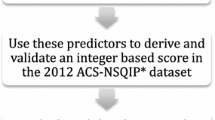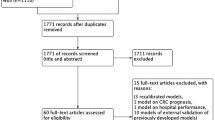Abstract
Background
Data on the factors that influence mortality after surgery in South Africa are scarce, and neither these data nor data on risk-adjusted in-hospital mortality after surgery are routinely collected. Predictors related to the context or setting of surgical care delivery may also provide insight into variation in practice. Variation must be addressed when planning for improvement of risk-adjusted outcomes. Our objective was to identify the factors predicting in-hospital mortality after surgery in South Africa from available data.
Methods
A multivariable logistic regression model was developed to identify predictors of 30-day in-hospital mortality in surgical patients in South Africa. Data from the South African contribution to the African Surgical Outcomes Study were used and included 3800 cases from 51 hospitals. A forward stepwise regression technique was then employed to select for possible predictors prior to model specification. Model performance was evaluated by assessing calibration and discrimination. The South African Surgical Outcomes Study cohort was used to validate the model.
Results
Variables found to predict 30-day in-hospital mortality were age, American Society of Anesthesiologists Physical Status category, urgent or emergent surgery, major surgery, and gastrointestinal-, head and neck-, thoracic- and neurosurgery. The area under the receiver operating curve or c-statistic was 0.859 (95% confidence interval: 0.827–0.892) for the full model. Calibration, as assessed using a calibration plot, was acceptable. Performance was similar in the validation cohort as compared to the derivation cohort.
Conclusion
The prediction model did not include factors that can explain how the context of care influences post-operative mortality in South Africa. It does, however, provide a basis for reporting risk-adjusted perioperative mortality rate in the future, and identifies the types of surgery to be prioritised in quality improvement projects at a local or national level.



Similar content being viewed by others
References
Juran S, Gruendl M, Marks IH et al (2019) The need to collect, aggregate, and analyze global anesthesia and surgery data. Can J Anesth 66:218–229. https://doi.org/10.1007/s12630-018-1261-5
Hannenberg AA, Warner MA (2009) The registry imperative. Anesthesiology 111:687–696. https://doi.org/10.1097/ALN.0b013e3181b786f3
Ng-Kamstra JS, Greenberg SLM, Kotagal M et al (2015) Use and definitions of perioperative mortality rates in low-income and middle-income countries: a systematic review. The Lancet 385:S29
Du Toit L, Bougard H, Biccard BM (2019) The developing world of pre-operative optimisation: a systematic review of cochrane reviews. Anaesthesia 74:89–99. https://doi.org/10.1111/anae.14499
Steyerberg EW, Vergouwe Y (2014) Towards better clinical prediction models: seven steps for development and an ABCD for validation. Eur Heart J 35:1925–1931. https://doi.org/10.1093/eurheartj/ehu207
Moonesinghe SR, Peden CJ (2017) Theory and context: putting the science into improvement. Br J Anaesth 117:482–486. https://doi.org/10.1093/bja/aew469
Protopapa KL, Simpson JC, Smith NCE, Moonesinghe SR (2014) Development and validation of the surgical outcome risk tool (SORT). Br J Surg 101:1774–1783. https://doi.org/10.1002/bjs.9638
Biccard BM, Madiba TE (2015) The South African surgical outcomes study: a 7-day prospective observational cohort study. S Afr Med J 105:465–475. https://doi.org/10.7196/SAMJ.9435
Biccard BM, Madiba TE, Kluyts HL et al (2018) Perioperative patient outcomes in the african surgical outcomes study: a 7-day prospective observational cohort study. Lancet 391:1589–1598. https://doi.org/10.1016/S0140-6736(18)30001-1
Kluyts H-L, le Manach Y, Munlemvo DM et al (2018) The ASOS surgical risk calculator: development and validation of a tool for identifying African surgical patients at risk of severe postoperative complications. Br J Anaesth 121:1357–1363. https://doi.org/10.1016/j.bja.2018.08.005
Meara JG, Leather AJ M, Hagander L et al (2015) The lancet commissions global surgery 2030: evidence and solutions for achieving health, welfare, and economic development the lancet commissions. Lancet 386:569–624. https://doi.org/10.1016/S0140-6736(15)60160-X
Collins GS, Reitsma JB, Altman DG, Moons KGMM (2015) Transparent reporting of a multivariable prediction model for individual prognosis or diagnosis (TRIPOD): the TRIPOD statement. Eur Urol 67:1142–1151. https://doi.org/10.1016/j.eururo.2014.11.025
Austin PC, Steyerberg EW (2017) Events per variable (EPV) and the relative performance of different strategies for estimating the out-of-sample validity of logistic regression models. Stat Methods Med Res 26:796–808. https://doi.org/10.1177/0962280214558972
Vickers AJ, Elkin EB (2006) Decision curve analysis: a novel method for evaluating prediction models. Med Decis Mak 26:565–574. https://doi.org/10.1177/0272989X06295361
Harris PA, Taylor R, Thielke R et al (2009) Research electronic data capture ( REDCap )— a metadata-driven methodology and workflow process for providing translational research informatics support. J Biomed Inform 42:377–381. https://doi.org/10.1016/j.jbi.2008.08.010
Altman DG, Vergouwe Y, Royston P, Moons KGM (2009) Prognosis and prognostic research: validating a prognostic model. Br Med J 338:b605. https://doi.org/10.1136/bmj.b605
(2018) Saving Mothers 2014–2016: Seventh triennial report on confidential enquiries into maternal deaths in South Africa: Short report. South African National Committee on Confidential Inquiries into Maternal Deaths
Watters DA, Hollands MJ, Gruen RL et al (2015) Perioperative mortality rate (POMR): a global indicator of access to safe surgery and anaesthesia. World J Surg 39:856–864. https://doi.org/10.1007/s00268-014-2638-4
Chazapis M, Gilhooly D, Smith AF et al (2018) Perioperative structure and process quality and safety indicators: a systematic review. Br J Anaesth 120:51–66. https://doi.org/10.1016/j.bja.2017.10.001
Marks IH, Fong ZV, Stapleton SM et al (2018) How much data are good enough? using simulation to determine the reliability of estimating POMR for resource-constrained settings. World J Surg 42:2344–2347. https://doi.org/10.1007/s00268-018-4529-6
Biccard B, Duys R, Nejthardt M et al (2018) It is time for Africa to lead the way in pragmatic trials editorial. South Afr J Anaesth Analg 24:1
Acknowledgements
Dawid EA van Straaten, Bioinformatician, Safe Surgery South Africa NPC.
Funding
None.
Author information
Authors and Affiliations
Corresponding author
Ethics declarations
Conflict of interest
The authors have no conflict of interest to declare.
Ethical approval
Data for the model derivation cohort were obtained from the African Surgical Outcomes Study, registered on the South African National Health Research Database (KZ_2015RP7_22), and on ClinicalTrials.gov (NCT03044899). The primary ethics approval was received from the Biomedical Research Ethics Committee of the University of KwaZulu-Natal, South Africa (BE306/15).
Additional information
Publisher's Note
Springer Nature remains neutral with regard to jurisdictional claims in published maps and institutional affiliations.
Electronic supplementary material
Below is the link to the electronic supplementary material.
Rights and permissions
About this article
Cite this article
Kluyts, HL., Conradie, W., Cloete, E. et al. Development of a Clinical Prediction Model for In-hospital Mortality from the South African Cohort of the African Surgical Outcomes Study. World J Surg 45, 404–416 (2021). https://doi.org/10.1007/s00268-020-05843-1
Accepted:
Published:
Issue Date:
DOI: https://doi.org/10.1007/s00268-020-05843-1




